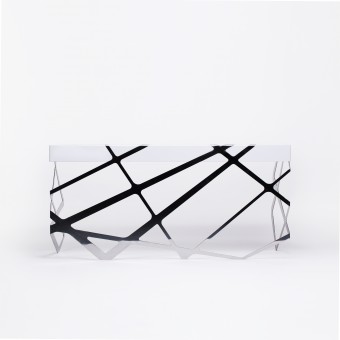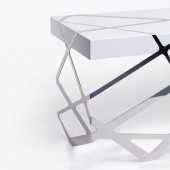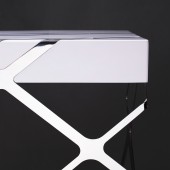
| THE AWARD |
| CATEGORIES |
| REGISTRATION |
| SUBMIT YOUR WORK |
| ENTRY INSTRUCTIONS |
| TERMS & CONDITIONS |
| PUBLICATIONS |
| DATES & FEES |
| METHODOLOGY |
| CONTACT |
| WINNERS |
| PRESS ROOM |
| GET INVOLVED |
| DESIGN PRIZE |
| DESIGN STORE |
| THE AWARD | JURY | CATEGORIES | REGISTRATION | PRESS | WINNERS | PUBLICATIONS | ENTRY INSTRUCTIONS |
Roots Home Desk by João Faria |
Home > Winners > Design #67114 >Interview |
 |
|
FS: What is the main principle, idea and inspiration behind your design?
JF: Roots is a home desk inspired in the Sacred Ceiba tree in Havana. The home desk Roots represents the geometry of that amazing tree in a contemporary design.
FS: What has been your main focus in designing this work? Especially what did you want to achieve?
JF: I wanted to interpret nature. This desk is unique and its inspiration was taken to its limits, which is a very commom feature in my designs.
FS: What are your future plans for this award winning design?
JF: This is not just a award wining design, it is a piece of art, which combines the design with the the artisans' knowledge and craftsmanship.
FS: How long did it take you to design this particular concept?
JF: The first drawing dates December 2013, but its conclusion only happens 4 years later, as several technical studies and prototypes were needed.
FS: Why did you design this particular concept? Was this design commissioned or did you decide to pursuit an inspiration?
JF: In spite of being inspired in a tree, its origins have always been present in our lives for a long time. We wanted to draw an object whose design was so strong that would perfectly represent its inspiration, which in this case was a tree.
FS: Is your design being produced or used by another company, or do you plan to sell or lease the production rights or do you intent to produce your work yourself?
JF: Roots is part of EMOTIONAL OBJECTS portfolio. Due to its extraordinary design, it won't be massively produced.
FS: What made you design this particular type of work?
JF: I was overwhelmed by the beauty of the tree, and I wanted to interpret nature in a contemporary way.
FS: Where there any other designs and/or designers that helped the influence the design of your work?
JF: Not in this particular case.
FS: Who is the target customer for his design?
JF: My designs are not for specific clients. This is a special home desk, which will certainly interact with people in many different ways.
FS: What sets this design apart from other similar or resembling concepts?
JF: This is a piece of art... pieces of art do not resemble concepts!
FS: How did you come up with the name for this design? What does it mean?
JF: I think I have already explained it... it was inspired in the Ceiba tree: a line that revolves around a volume leaving traces with different expressions, just like a root in a tree, intercepted with a volume on top.
FS: Which design tools did you use when you were working on this project?
JF: CAd program to visualize the object.
FS: What is the most unique aspect of your design?
JF: The technical complexity: the laser cutting and CNC methods alongside the handcrafted mastery.
FS: Who did you collaborate with for this design? Did you work with people with technical / specialized skills?
JF: High skilled artisans and their valuable knowledge.
FS: What is the role of technology in this particular design?
JF: Indispensable. The technology (laser cut and router cutting) is the most advanced in the market, combined with highskilled artisans.
FS: Is your design influenced by data or analytical research in any way? What kind of research did you conduct for making this design?
JF: In this particular case, my research was focused on more technical aspects. I wanted this object to reinterpret nature, the overwhelming tree shape, but, at the same time, it was necessary to make it functional.
FS: What are some of the challenges you faced during the design/realization of your concept?
JF: The main challenge was its implementation because technically it is a very complex design. Different studies and prototypes were developed so that the object could be functional and sturdy.
FS: How did you decide to submit your design to an international design competition?
JF: I really think this is not a common desk... it is a piece of art, so it deserved to be shown.
FS: What did you learn or how did you improve yourself during the designing of this work?
JF: I always learn something in all my designs and experiments. Mostly that it takes skill and art to make EMOTIONAL OBJECTS come true.
FS: Any other things you would like to cover that have not been covered in these questions?
JF: I think the main ideas were covered. Thank you!
FS: Thank you for providing us with this opportunity to interview you.
A' Design Award and Competitions grants rights to press members and bloggers to use parts of this interview. This interview is provided as it is; DesignPRWire and A' Design Award and Competitions cannot be held responsible for the answers given by participating designers.
| SOCIAL |
| + Add to Likes / Favorites | Send to My Email | Comment | View Press-Release |





